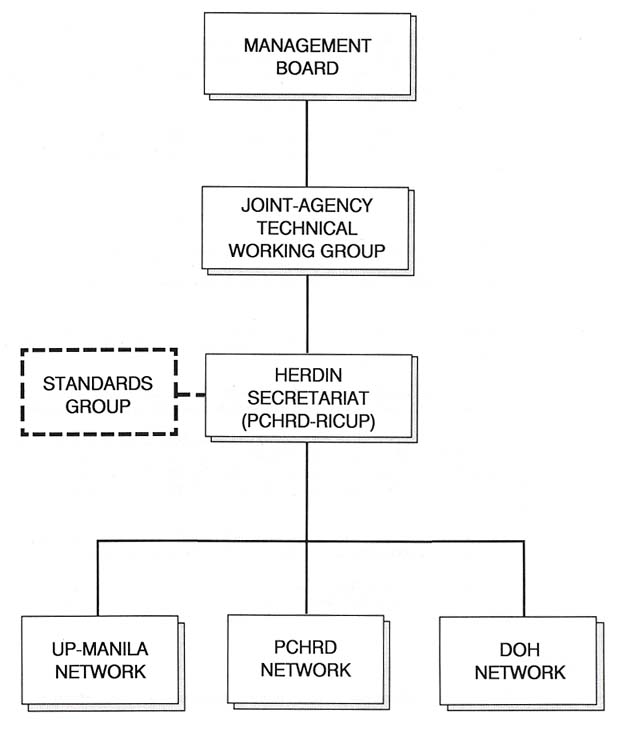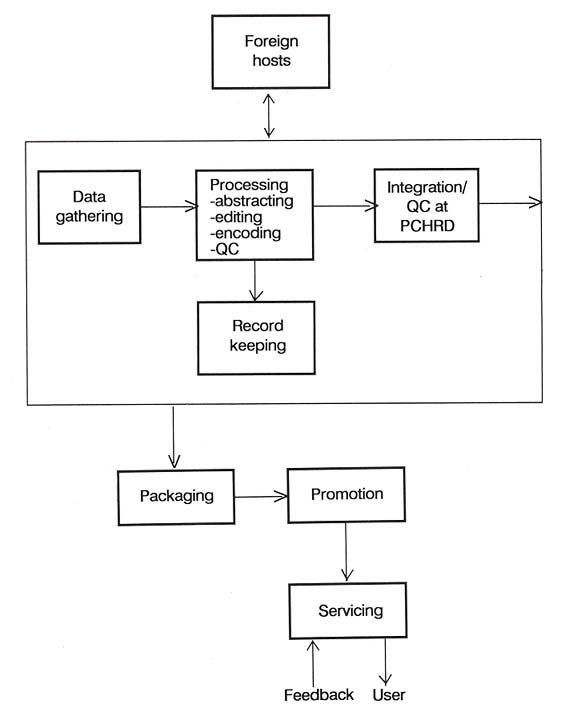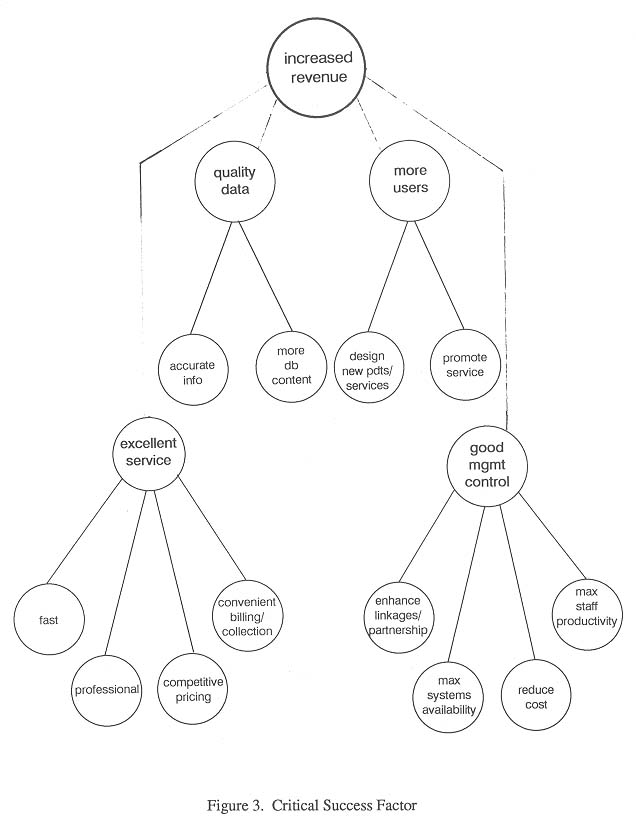
Figure 1. HERDIN Organizational Chart
Merlita M. Opena
Research Information, Communication & Utilization
Program
Philippine Council for Health Research and Development
Deptartment of Science and Technology
Manila, Philippines
Abstract: The paper presents the experiences of the Philippine Council for health Research and Development (PCHRD), gained as secretariat of both the Health Research and Development Information Network (HERDIN-Philippines) and the Asian-Pacific Information Network of Medicinal Aromatic Plants (APINMAP), as it redefined its mission within the information business.
Particular attention is given to its shift in orientation, from a pure non-profit producer of information from databases to an entity with a business objective. By matching its infor-mation systems with its business strategies, information technology becomes its compe-titive advantage.
Discussed also are the strategies adopted to market its databases, as well as designing value-added products and services and costing them.
The experiences of Philippine Council for Health Research and Development (PCHRD) as the lead agency in the Health Research and Development Information Network (HERDIN) depict a continuing process of change.
Originally, PCHRD was just concerned with establishing a library network, and in the process develop computerized bibliographic databases.
The organization of HERDIN, by itself, was no mean feat as it turned out. The organizers had to look at the bigger picture, beyond the concerns of libraries and librarians, because the whole system has a lot of players -- each playing an important role. This is in addition to the absence of a working model.
Aside from knowing the environment, one has to also contend with delivering the products and services of the network to its appropriate users. This, again, needs a different orientation.
One has to assess the cost-effectiveness of the outputs. In the end, will they sustain operations as well as leave space for expansion?
These are tough questions especially for information professionals who are working within the government sector and those in non-profit organizations.
The discussions in this paper refer mostly to HERDIN, although PCHRD is also the secretariat of Asia-Pacific Information Network on Medicinal and Aromatic Plants (APINMAP). This is because HERDIN provided the building block for all other linkages.
2. BACKGROUND ON HERDIN
The Philippine Council for Health Research and Development (PCHRD) is one of the five sectorial planning councils of the Department of Science and Technology (DOST) tasked to coor-dinate all health R & D activities in the country.
PCHRD's coordination function is performed through a series of consultations with the doers, users, administrators, and supporters of research. From these consultations, a National Health R & D Plan (NHRDP) is evolved which serves as a blueprint for health research in the country. This plan is implemented by PCHRD.
In the consultations held by PCHRD, there was a repeated demand to make more information easily accessible to users in the health research community.
This information was needed to serve various purposes. For PCHRD and other planners, the availability of health research information will enable them to plan and allocate resources accordingly. For researchers, it will mean that they do not have to work on areas that had already been researched, or they can use the results of their colleagues to do further research.
In response to this need, PCHRD led the creation of HERDIN in 1987, a strategy that is supportive of NHRDP's objectives.
Basically, HERDIN is a library network of institutions engaged in health research. Thru sharing of information resources, a bigger information base is made available.
To ensure that HERDIN captures and serves the needs of its users, it involved the academe, where most the researches are done, and the health service delivery sector who are expected to use the results of researches. With these criteria, the initial membership of HERDIN was composed of PCHRD, UP Manila, and Department of Health (DOH).
HERDIN is a government initiative. The International Development Research Centre of Canada supported its establishment with a project grant. Support were also given by UNESCO, British Council and World Health Organization.
In terms of structure, HERDIN is dovetailed to existing programs and structures. There is no separate structure. That is, within PCHRD, this is part of the Research Information, Communication and Utilization Division (RICUD). As well, within DOH, this is under the Research and Documen-tation Section of the Health Manpower Development and Training Service (RDS-HMDTS) -- while in UP Manila, the correspondent unit is the university library.
As well as the lead agency, PCHRD is also the secretariat. Thru RICUD, it manages the network. It liaises with the Management Board as well as the Joint Agency Technical Working Group (JATWG) which prepares and implements the work plan as approved by the Management Board. Figure 1 shows the HERDIN Organizational Chart.
The member institution is expected to contribute to the following HERDIN objectives:
• to develop computerized bibliographic databases of Philippine health literature;
• to enhance access to international databases; and
• to maximize the use of information contained in HERDIN databases as well as its other products and services.
Each node is a subnetwork by itself. As such, the correspondent unit in each member institution takes care of data gathering, verification, and entry to computers of data from within its subnetworks. Likewise, it takes care of servicing queries from its client base.
The secretariat does the final quality control and integration of nodal data inputs. This is done every quarter. With new inputs, a full copy of the database is downloaded to each of the nodes.
Whatever linkages established by each of the member which has bearing on HERDIN is made accessible to the rest of the network. For example, PCHRD's participation in the Asian-Pacific Information Network in Medicinal and Aromatic Plants (APINMAP) brings to the network another information base to tap. UNESCO's support is instrumental in APINMAP's formation and continued operation.
As regards resources, each member works within each own budget. The initial project fund supplemented these internal budgets, especially in terms of staffs and equipment purchases.
As project funds diminish, the members now have to rely to their own agency budgets, which, in turn, continue to dwindle. Unless new grant monies come in, a new scheme has to be adopted to make HERDIN products and services self-liquidating concerns.
3. DESIRED DIRECTIONS
HERDIN envisions to cut to an optimum level its turnaround time for servicing information requests.
It also wants to generate more value-added products and services, like translation of present databases into portable compact discs for easy marketing; publication of materials resulting from in-depth analysis of information contained in its databases; among other things.
It also wants to strengthen its position as trainer institution.

Figure 1. HERDIN Organizational Chart
To do this, it has to have a market orientation to deliver its products to its users. It has to also rationalize its operation so that it is able to respond to the demands of this shift into market orientation.
To enable HERDIN supporters and workers to see where it is going, the following mission statement and definition of its business were formulated.
3.1. HERDIN Mission Statement
HERDIN aims to provide information to health workers and other people who will use these information to improve health care, thus, contributing to the quality of life of the Filipinos.
3.2. HERDIN Business
HERDIN is in the information business. It intends to become the information center for researchers seeking to know the latest developments in health, local or international. As such, it will establish linkages with all major players in the information business to foster mutual growth. It aims to deliver to the consumer excellent service thru quality information, within minimum time, with the use of information technologies. Its people adheres to a conduct of service which places the customers first. A good atmosphere and a package of incentives is put in place to enable service providers to perform what is expected of them.
4. MARKET
The new directions that HERDIN is embarking require a good definition and understanding of its market. It is, thus, necessary for it to know if it can profitably survive in the business it has decided to go into.
4.1. Information Market
A French consultant, Jacques Faure, estimated the world's bibliographic information at $11billion US dollars, 50% of which is accounted by publications. The figures used for databases are only those housed by commercial database hosts.
In Europe, the whole data acquisition, analysis, processing, and maintenance is placed at PHP 1000/record. Searching fees vary. Some database servers charge a monthly membership fee which gives a certain among of time online every month, with extra time charged by the minute. Others either use timed usage rates or a search fee.
In the US, online connections to the medical databases at the National Library of Medicine (Maryland) cost $2/five minutes. An average user spends 10-20 minutes doing a search, and the same length of time to pick up his results. With experience, search time drops to five minutes.
Document delivery, that is, the dispatch of full journal articles (in contrast to bibliographic citation searched from computer databases) costs PHP 160/document if taken from the British Library Document Supply Center.
The Philippine does not have yet a well defined information market as regards bibliographic databases. At best, these developments are sporadic and are concentrated in government and non-profit institutions.
4.2. Profile of Users
The users of information in the health community are different, in the sense that they do not stop studying, thus, reading. The health professionals, especially the medical doctors, cannot afford not to read as this will impact on their delivery of health care services.
For health researchers, journals are the best sources of the latest information, next to their peers.
Since they are always pressed for time, they would rather go through abstracts of articles of their special areas, and decide later from which among the list where a full article is necessary.
Most often the abstracts already satisfy the researcher's information requirement. Very seldom are requests for full articles necessary.
Table 1 outlines the potential users of HERDIN. The major users are
concentrated in the National Capital Region and Cebu. This also reflects
the location of leading medical centers, universities, and research organizations.
Table 1. Users of HERDIN
Pharmaceutical & Private Companies 200
Medical/Paramedical Schools 451
Research Institutes 126
2. Individual
Users
592,005
Health Professionals 415,753
Students
(Health & Health Related Course) 176,252
There is, however, a big number of users, still untapped, from the other health and allied disciplines.
4.3. Products and Services
HERDIN's products may be classified into the following:
• Local Database of health research projects, manpower, institutions, and published articles
• Literature Search service searchers can avail of these services by writing, calling, or connecting online, and get the results in paper copies, diskettes, or by reading these in their computer screens.
• Selective Dissemination of Information (SDI) is for specialists who want to receive regular abstracts of articles within their areas of specialization. A subscriber, in this case, receives an update every quarter.
• Document Delivery offers researchers full copies of articles they wish to read from a list of abstracts received. Sourced from HERDIN member libraries, these documents are delivered by post or courier service.
• Software Training on CDS/ISIS, a software developed by UNESCO, for text retrieval applications.
• Publications produced regularly by the council and its consultants.
4.4. Competitive Analysis
Industry Competition. In the health sector, no similar literature search service exists. There are, however, new initiatives in the nutrition and population subsectors. Since these groups work with HERDIN, they are, therefore, seen as partners because they help ensure that there are more data available in the network.
Potential Entrants. New developers will have to contend with building up a network of infor-mation sources and processors. Consequently, the start-up costs, especially for investments in equipment, are inhibiting factors.
Substitutes. The substitute for HERDIN's computerized literature search service is the traditional manual scanning in the library catalogues. If a library is not into networking, the searcher will be limited to the resources of his library. An alternative will be to buy personal copies of journals and publications.
Buyers. The profile of the users, especially health specialists, showed that they place premium on speed and accuracy of the information they are searching. In addition, compared to other resear-chers, they have purchasing power that enables them to pay for the information they want.
Suppliers. The suppliers of local information are the researchers themselves, institutions doing research and publishing, and the libraries. With resource sharing and exchange arrangements in place, gathering information from these sources is facilitated. The absence, however, of a good filing/recording system (true for individual researchers) makes data gathering difficult. For inter-national databases, development agencies (like IDRC or UN) usually give free copies to government or non-profit organizations. These databases, when made searchable locally, add to the wealth of information available. Extra efforts, however, have to be exerted to look for these sources. There are also commercial database hosts abroad who packages these information into newer media, such as compact discs. These hosts obtain these databases from primary producers like the National Library of Medicine (US) or related bodies.
5. HERDIN OPERATIONS
There are four major operations in HERDIN, namely: production, marketing, servicing, and network management.
Knowing each of these operations was necessary to identify the resource and cost requirements.
5.1. Production
Production consists of data gathering, processing, quality control, computer entries, and maintenance of records in the databases. This also includes sourcing of information from other database hosts, local or international.
The creation of a record, given the present staff capability and systems developed, involves several types of expertise. Not counting the turnaround time from subject matter specialists (SMS), it takes 4.5 hours. The imprimatur of a SMS is very important since this ensures the accuracy and validity of the data.
The cost per record is PHP 183 excluding data gathering, systems development and mainte-nance.
5.2. Marketing
In terms of marketing, HERDIN promotes the service through its brochures distributed during seminars and exhibits. Product demonstrations accompany these sessions.
A regular insert within the quarterly PCHRD Bulletin is devoted for HERDIN news. This is distributed to libraries, individual researchers, and contacts within the health research community.
Articles about HERDIN are also sent to editors of specialty journals to inform their subscribers of HERDIN's products and services.
These activities contributed to an increased demand for HERDIN services. However, to be a going concern, this is where more efforts have to be exerted.
Pricing has just been firmed up especially for online and SDI services. Before, the services were basically free.
5.3. Information Services
Usually the service staff interviews the user, using a questionnaire, to focus the search, and, thus, not waste time. Searching an be done directly by the user, or by the staff.
The service provider is a key person here. A good subject background plus a working know-ledge on information technologies are ideal. Most importantly, staff professionalism will spell a repeat usage of the service as well as a snowballing effect towards an increasing user base.
5.4. Network Management
Considering that there are three big institutions involved, network management becomes tricky, especially so that the level of growth is not equal.
Options to spin off HERDIN as a separate business concern are being looked into. This ensures that efforts become more focused. It also means that a real market-orientation has to be in place. Figure 2 shows the network transaction chart.
6. INFORMATION TECHNOLOGY AS A COMPETITIVE TOOL
The information industry is continually growing. In fact, the global technology thrusts have bearings on its continued growth.
With better products coming out, information technology (IT) becomes pervasive, especially with the parallel growth of knowledge-based organizations. HERDIN realizes that IT will be its strategic tool for the design and delivery of its products and services. IT will also shape its organization's strategies and architecture to attain all the critical success factors depicted in Figure 3.

